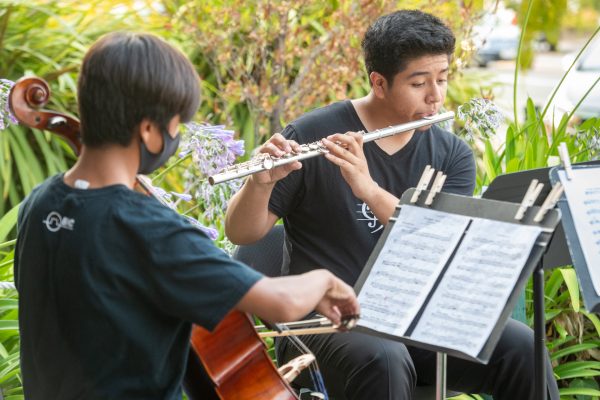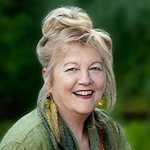Marin’s high school seniors start their college applications this fall. Arts equity programs have helped Marin’s low income Latinx immigrant students reach for top colleges. Jane Kramer, founder and executive director of Enriching Lives Through Music (ELM), thinks these students will realize their dreams.
“When I started ELM, the opportunity was originally the impetus,” Kramer said. “I knew that if we provided superb teachers, high-quality instruments, and convey that we had high expectations of their abilities, they would thrive, not only musically, but socially, academically, and emotionally. I hoped they could internalize that feeling of success and transfer it into anything they set their hearts or minds to doing. They could accomplish anything. I now see our ELM kids able to spread their wings and excel.”
ELM starts children at the age of 7, providing them with an instrument and teaching them how to play it, free of charge. By age 9, they’re already excellent musicians who have learned what it means to have discipline and focus, practice independently at home, and create goals and priorities.
I knew that if we provided superb teachers, high-quality instruments, and convey that we had high expectations of their abilities, they would thrive, not only musically, but socially, academically, and emotionally.
– Jane Kramer, Founder and Executive Director, Enriching Lives Through Music
Kramer started ELM to address what she saw as a complete lack of opportunity to participate in a high-quality instrumental ensemble program for young children in the Canal neighborhood, where there is a concentration of low-income housing and a predominately Latino immigrant community. Without a rigorous instrumental music education in elementary school, joining the vibrant bands or orchestras they might find when they went to middle school wasn’t easy. Aside from that hurdle, many had to take English as a second language in middle school as their one elective. So, even when they entered a school where they could play an instrument, access to participation in an ensemble was challenging.
Like ELM, Youth in Arts (YIA) has seen students blossom from the arts when any subject integrates visual arts, drama, dance, and music. Research indicates that students who are engaged in learning with arts integration act out less and improve test scores, mainly with youth facing extraordinary challenges in life.
Recently, YIA has been using what they learned during COVID to reach more students more equitably. They believe so much in what they’ve learned that the organization provides the pilot to Bayside MLK, even though the program is currently unfunded. YIA is confident they can scale this program. They would like to target Marin’s 13 Title I schools. While it is not a replacement for having an arts educator in the classroom, schools that don’t have an arts program for whatever reason, whether it is geography, finances, resources or time, can use this model in creative ways to bring the arts into the classroom in a meaningful way.
YIA’s Executive Director Kristen Jacobson explained, “We are experimenting with a hybrid model, combining ongoing virtual learning with in-person visits along with what we discovered to be a best practice: we include an analog component, for multi-module learning. We are piloting this with Bayside MLK in Sausalito Marin City School District, with a 24-week program.”
In the Fall, the fifth-grade students at Bayside MLK will get an Architecture and Design program led by one of YIA’s teaching artists. Three of the lessons will be with a visiting artist in the classroom. The other nine lessons are all virtual via the platform YIA built last year. In the spring, they will do a similar format with three of the lessons with a dance artist in the classroom. The rest of the residency will be virtual.
YIA celebrated its 50th Anniversary this year. Not content to rest on their laurels, staff turned a strategic lens on all innovations and the other things they learned during the pandemic. Their goal is to reach more students, both in numbers and geographically. They combined their virtual learning into a digital, online platform called the YIArts.COR, which stands for Creative Online Resources.
YIA is experiencing its biggest year ever, fully serving four San Rafael City Schools and several others in Marin and Richmond. Jacobson hopes to prioritize bringing creativity into the classroom, and that access to funds continues. The federal and state Learning Loss Mitigation Funding from three different funding sources allocated to local educational agencies to mitigate the effects of COVID-19 school closures’ learning loss may help.
Jacobson said that in the spring, at the end of the semester, they found that by showing their videos, the in-school educators were more empowered and confident in using the arts in the classroom.
“Can we use this virtual learning combined with in-person learning to reach and make arts education more equitable? Especially for schools that either couldn’t afford us or we couldn’t afford to send a teaching artist into the classroom for 12 or 24 weeks,” Jacobson said. “This includes places like Bolinas.”
Over the years, ELM has seen the growth of kids engaged with families and the community because ELM has always been a family affair. It’s no secret that a positive family connection impacts an individual’s lifetime success and healthy choices.

This summer, ELM collaborated with the San Francisco Chamber Orchestra to host a two-week intensive chamber music program. Plus, several students reached milestones:
“We commit to our students for up to 10 hours a week, for 10 years starting when they are in second or third grade,” Kramer added. “More recently, we added academic tutoring to our program with 40 volunteer tutors last year, and many are staying on for next year.”
Some of the older students who’ve been with the program 8-10 years are tutoring the younger students in music and other academic areas. The field of research on the benefits of music education is extensive. An article in The Atlantic details the benefits of music education and its positive impact on children in low-income communities. ELM, like YIA, sees the results every day.
For more information please visit Enriching Lives Through Music and Youth in Arts online.

Kate Fitzsimmons is a freelance writer and fund development professional. Her writing skills were honed as a Contributing Editor to The San Francisco Review of Books where she interviewed John Updike, Joyce Carol Oates, Bobbie Ann Mason, Alice Walker and others. She works with businesses, nonprofits and entrepreneurs to assist them in raising their visibility through their stories. When she isn’t writing, she is cooking for friends, collecting art or engaged in a good novel.